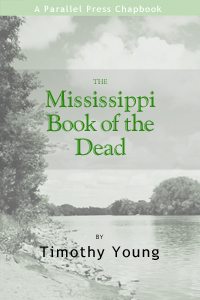Book Review
Timothy Young, The Mississippi Book of the Dead, Parallel Press, 2013
Reviewed by John Olski
Timothy Young’s 78-stanza poem The Mississippi Book of the Dead channels midlife unrest into a kind of pan-heartland pilgrimage, transforming mundane observations of place into a numinous whole. The poem’s narrator finds inspiration in his memory of “a man who walked all India / from the tip to the Chinese border,” a Hindu who “At fifty… wanted to learn his new path.” Young remakes that quest American-style: by car on a Mississippi River road trip, with a mixture of description and reference that underscores the amalgamated natures of language and culture.
Young’s chosen poetic form conveys the weight of ancient Greek measured verse in its pacing, with each numbered stanza roughly following the same pattern: four lines each of a sentence, clause or long phrase, followed by one line of phrase (space) phrase (space) phrase. Young’s Parallel Press chapbook notes that the long poem began as a shorter one set to music, and the cantatory effect is apparent.
A better title for the poem might have been River Road Book of the Dead, as suggested by stanza 35:
I’m headed somewhere but lost among places
called Alma, Pike’s Peak, Guttenberg, Savanna,
Louisiana, Mexico, Hannibal and Canton –
all on one long road.
Where in Hell am I?
The narrator moves from Mississippi River headwaters in Minnesota to delta sands in Louisiana. He remarks on river wildlife, people in rest stops and cafes, human-made features from Indian burial mounds to the St. Louis arch, tourist traps, native sons from Ulysses Grant to Kermit the Frog, and Hurricane Katrina damage. All of it coheres in the way that, to a reader, Alma may be a woman’s name, Pike’s Peak a mountain, Guttenberg a printer, Savanna a grassland, Louisiana a state, Mexico a country, Hannibal a conqueror, and Canton a Swiss political unit, though all can be linked as place names along the Mississippi’s river road.
Multiple cultures (ancient Egypt, Tibet) have created books of the dead to guide departed souls, and the river road guides a narrator who feels figuratively dead. The journey-as-poem becomes a road book back to life, an exercise in re-engaging the world. “A fat, old woman scowls at a rest stop,” the traveler notes in stanza 72, “but I smile and she gives me a grin and a twinkle.”
A portion of the poem addresses post-Hurricane Katrina New Orleans and efforts to help that region return from its own near-death, with images stark as video footage. Poetry offers another way to rebuild: if the poet tells us that "Food rots in thousands of overturned Fridge’s,” he also helps us see it as “A cemetery with decay above ground,” suggesting the usual order of New Orleans crypts within the chaos. It’s a metaphorical reframing that can be found at various levels of the poem, offering readers a model for engaging the complexities of their own lives.
The Mississippi Book of the Dead reads wonderfully as a poetic essay, and would offer many points of entry for book group discussion. It’s also a fine model for poets looking to write in longer forms. Diction is straightforward, metaphors are varied in complexity, and the reading experience offers a compelling hauntedness you’d expect from a Book of the Dead. It’s a poem to be reread at times when life seems too unstructured.
John Olski is a Library Associate for Brown County and a former adjunct instructor of college composition.


